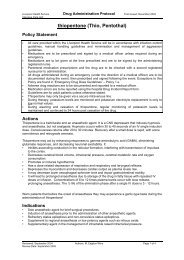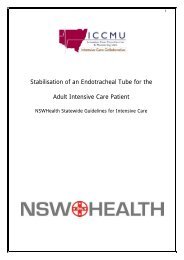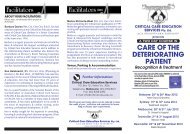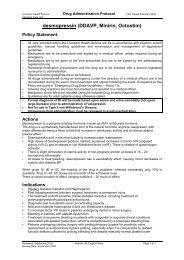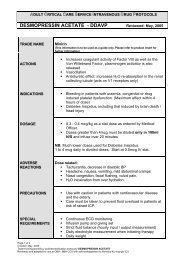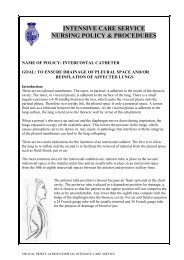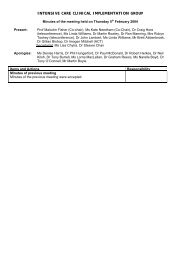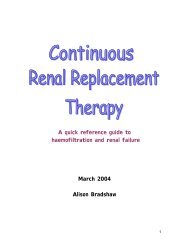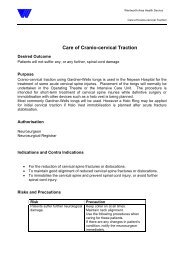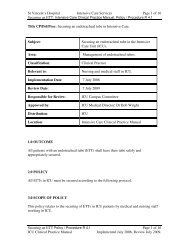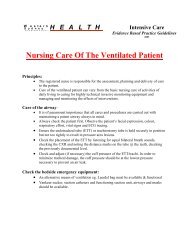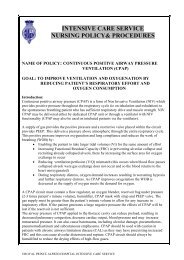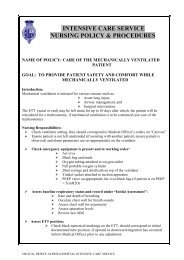CRITICAL CARE
CRITICAL CARE
CRITICAL CARE
You also want an ePaper? Increase the reach of your titles
YUMPU automatically turns print PDFs into web optimized ePapers that Google loves.
Central Sydney Health Service Royal Prince Alfred Hospital<br />
This is a ventilator protocol based on the ARDS Network study published in the New England<br />
Journal of Medicine (NEJM 2000;342:1301-8). This was a trial of 861 patients with Acute Lung<br />
Injury (ALI) or Acute Respiratory Distress Syndrome (ARDS) that were randomised to receive<br />
ventilation using tidal volumes based on ideal body weight (IBW) derived from height. The<br />
conventional ventilation group received tidal volumes of 12 ml/kg IBW and the low tidal volume<br />
using 6 ml/kg of ideal body weight (IBW). The study found that patients in the low tidal volume<br />
group had a significantly lower mortality (31% compared to 40%, p=0.007) and a shorter time on<br />
the ventilator (10±11 days vs. 12±11 days, p=0.007).<br />
This is a version of the ARDS Network protocol for low tidal volume ventilation for use on the<br />
Dräger “Evita XL” or “Evita 4” ventilator in ICU at RPAH.<br />
This ventilator protocol is not appropriate for patients with raised intracranial pressure,<br />
spinal cord injury, tricyclic antidepressant overdose, Sickle cell disease, or other conditions<br />
where hypercapnoea would not be tolerated.<br />
INITIAL VENTILATOR SETUP<br />
To Calculate Ideal Body Weight (IBW):<br />
� Tidal volumes are calculated from an ideal body weight calculation, which is derived<br />
from the patient’s height only. It is usually less than the actual body weight.<br />
� Using “Carevue”, go into patient demographics and add patent’s height. IBW will then<br />
be calculated and is displayed in the ventilation window.<br />
� The IBW is calculated from the equations below:<br />
� Males IBW (kg) = 50 + 0.91(height (cm) –152.4)<br />
� Females IBW (kg) = 45.5 + 0.91 (height (cm) –152.4)<br />
Follow steps below for setup:<br />
ARDS NETWORK PROTOCOL FOR<br />
LOW TIDAL VOLUME<br />
MECHANICAL VENTILATION<br />
� Using ‘Carevue’ select ARDS Net protocol in the ‘Add Row’ window. This will bring up<br />
all the necessary required measurements.<br />
� Select the mode as CMV. In this mode, every breath the patient triggers is given at the<br />
set tidal volume. If the patient is not breathing, they will be given the set respiratory rate.<br />
However, if their respiratory rate is higher than the set rate all breaths will be delivered at<br />
the set tidal volume.<br />
� Select Initial tidal volume as 6ml/kg IBW<br />
Version 2.1
Central Sydney Health Service Royal Prince Alfred Hospital<br />
� Set respiratory rate to maintain the minute ventilation (MV) that was recorded prior to<br />
changing the ventilator settings (set f = old MV divided by new VT in litres). This may not<br />
be possible as the maximum set respiratory rate (f) is 35<br />
� Ensure that Autoflow is turned on.<br />
� The airway pressure alarm must be set at 35 cm H2O.<br />
This will limit the maximal airway pressure to 30 cm H2O.<br />
� Turn the Flow Trigger “On” and set it to 2 L/min<br />
� Adjust the Inspiratory time to start with an I:E ratio of 1:3. I:E ratio is displayed in the<br />
bottom left corner of the “Ventilator settings” screen when Tinsp is selected.<br />
� Adjust the FiO2 and PEEP as outlined in the section arterial oxygenation goal<br />
(see below).<br />
SUBSEQUENT VENTILATOR ADJUSTMENTS<br />
TIDAL VOLUME AND INSPIRATORY TIME ADJUSTMENTS<br />
� These may be necessary if the alarm “pressure limited, volume not constant” occurs.<br />
This alarm indicates that the ventilator cannot deliver the programmed volume in the time<br />
allowed whilst keeping the pressure under the alarm limit of 35 cm H2O (actual airway<br />
pressure of 30 cm H2O). In this case the ventilator will deliver a lower tidal volume,<br />
rather than exceed the pressure limit. There are two solutions to this problem.<br />
1) Increasing the inspiratory time allows more time for the set tidal volume to be<br />
delivered without exceeding the pressure limit. Initially, the Tinsp should change I:E<br />
ratio from 1:3 to 1:2. If this does not help an I:E ratio of 1:1 should be used.<br />
2) If the above does not resolve the alarm reduce the tidal volume in one ml/kg IBW<br />
increments. This may be repeated every few minutes to a minimal tidal volume of<br />
4 ml/kg IBW. The tidal volume should not be reduced below this. If a tidal volume<br />
of 4 ml/kg is necessary, medical staff should be made aware.<br />
� If the patient’s tidal volume is less than 6 ml/kg IBW, regular attempts should be made to<br />
increase it, in 1 ml/kg IBW increments, back towards 6 ml/kg. The ability to do this will<br />
be limited by the alarm “pressure limited, volume not constant” as described above. A<br />
tidal volume of 8 ml/kg may be used after discussion with the ICU consultant and<br />
documentation in the notes.<br />
� If the patient is receiving 6 ml/kg IBW, attempts should be made to reduce the inspiratory<br />
time to give an I:E ratio of 1:3.
Central Sydney Health Service Royal Prince Alfred Hospital<br />
ARTERIAL OXYGENATION GOAL<br />
Goal: SpO2 = 88 to 95 % or PaO2 = 55 to 80 mm Hg if ABG available<br />
� Adjust the FiO2 and PEEP according to the combinations outlined below. This can be<br />
performed every 5-10 minutes.<br />
� Adjustment to oxygenation can be made on SpO2 alone. It is not necessary to do blood<br />
gases to change FiO2. Blood gases should be performed as indicated. However, if a PaO2<br />
is available adjustments are made based on it, rather than SpO2.<br />
Fi02<br />
Peep<br />
0.3<br />
5<br />
0.4<br />
5<br />
0.4<br />
8<br />
0.5<br />
8<br />
0.5<br />
10<br />
0.6<br />
10<br />
ARTERIAL pH and PaCO2 / EtCO2<br />
Goal: pH = 7.30 – 7.45<br />
0.7<br />
� Leave the respiratory rate at the current settings<br />
Acidosis management: pH 7.10 – 7.30<br />
� Increase the ventilator rate until pH > 7.30 or PaCO2 < 35<br />
� PaCO2 is related to minute ventilation (MV = Vt x f)<br />
� Increasing f increases MV and “blows off” CO2 increasing pH<br />
� Maximum set ventilator rate is 35 bpm<br />
Acidosis Management: pH < 7.10<br />
� Increase the set ventilator rate to 35 bpm<br />
10<br />
� If pH remains < 7.10, tidal volume may be increased in 1ml/kg IBW steps until pH > 7.10<br />
Inform the senior register or duty consultant of an increase in tidal volume above 8 ml/kg<br />
IBW<br />
Alkalosis Management<br />
� Decrease the ventilator rate if possible<br />
0.7<br />
12<br />
0.7<br />
14<br />
0.8<br />
14<br />
0.9<br />
14<br />
0.9<br />
16<br />
0.9<br />
18<br />
1.0<br />
20-<br />
24
Central Sydney Health Service Royal Prince Alfred Hospital<br />
WEANING FROM THE MECHANICAL VENTILATION<br />
� The weaning process is initiated by a CPAP trial. This should only occur once each day<br />
if the correct criteria are met (see indications for CPAP trial). It should only be initiated<br />
by the consultant or senior registrar and will usually be initiated on the ward round.<br />
WEANING FAILURE<br />
� Any weaning process (CPAP trial or Pressure Support Weaning) is considered to have<br />
failed if any of the following occur:<br />
� f > 35/min<br />
� Sp02 < 88%<br />
� Respiratory distress is present (more than 2 of the following)<br />
� Pulse >120% of the usual rate for >5 minutes<br />
� Marked use of accessory muscles<br />
� Abdominal paradox<br />
� Diaphoresis<br />
� Marked complaints of dyspnea<br />
� Should weaning failure occur the patient is placed back on CMV until the next day<br />
CPAP TRIAL<br />
� Conduct a CPAP trial daily when all the following are present:<br />
� Fi02 ≤ 0.4 and PEEP ≤ 8 cm H20<br />
� Subject has spontaneous breathing efforts.<br />
It may be necessary to decrease set rate by 50% for 5 minutes to detect respiratory<br />
efforts<br />
� Haemodynamically stable<br />
� To set CPAP of 5 cm H20 and Fi02 0.50<br />
� Set mode on the Dräger to PSV<br />
� Set PS 0 cm H2O<br />
� Set PEEP 5 cm H2O<br />
� Set FiO2 to 0.5<br />
� If f ≤ 35/min for 5 minutes<br />
� Advance to Pressure Support Weaning Procedure<br />
� If f > 35/min in < 5 minutes<br />
� CPAP trial not tolerated<br />
� return to previous CMV ventilator settings and reassess the next morning.<br />
� Occasionally it may be appropriate to repeat the trial after an appropriate intervention<br />
such as suctioning, analgesia, or anxiolysis if these contributed to weaning failure.
Central Sydney Health Service Royal Prince Alfred Hospital<br />
� In CareVue record on the “CPAP trial” line (ventilation window) whether the CPAP<br />
trial was PASSED or FAILED<br />
PRESSURE SUPPORT (PS) WEANING PROCEDURE<br />
Initial Pressure support settings:<br />
� Set PEEP 5 cm H20 and Fi02 0.5<br />
� Set initial PS based on f during CPAP trial:<br />
� If CPAP f < 25 /min<br />
� Set PS 10 cm H20<br />
� If CPAP f = 25-35 /min:<br />
� Set PS 20 cm H20<br />
Subsequent pressure support weaning settings:<br />
� Subsequent Pressure Support adjustments are made on respiratory rate (f) every 10-<br />
15min<br />
� If f > 25 increase Pressure Support by 2 to 5 cm H2O<br />
� Maximum pressure allowed, PEEP + PS = 30 cm H2O<br />
� Pressure airway alarm should be at 35 cm H2O<br />
� If f < 20 decrease Pressure Support by 2-5 cm H2O<br />
� If f > 35 and/or PEEP + PS > 30 cm H2O weaning has failed and CMV is initiated as<br />
above<br />
Subsequent Oxygen and PEEP Adjustments:<br />
� Adjustments are made as per Oxygenation Goals outlined above<br />
� If FiO2 > 0.5 and PEEP > 10 cm H2O are required while on pressure support ventilation,<br />
strong consideration should be given to reinitiating CMV as above. Inform the medical<br />
staff.<br />
EXTUBATION / SWEDISH NOSE VENTILATION<br />
� Extubation or spontaneous ventilation via a Swedish nose and tracheostomy should be<br />
considered if the following criteria are met.<br />
� f < 30 on Pressure support 5-7 cm H2O<br />
� Oxygenation goals are met with<br />
� PEEP of 5 cm H2O<br />
� FiO2 of 0.4 or less
Central Sydney Health Service Royal Prince Alfred Hospital<br />
Occupational Health and Safety: Universal precautions taken in the preparation, administration of drug and<br />
disposal of equipment and sharps.<br />
Cross Referenced: RPAH Occ. Health & Safety Manual and Infection Control Manual<br />
NSW Infection Control Policy 98/99<br />
Revised by: Clive Woolfe October 2, 2003<br />
Authorised by: Clive Woolfe, Intensivist<br />
Revision due: 2005<br />
With the introduction of Powerchart online ordering, a clinical agreement has been set up with the Director<br />
of ICS and other Staff Specialists. Nursing Management, with the agreement of the hospital executive, have<br />
made arrangement that allows all permanently employed RPAH Nursing Staff to place orders for a variety of<br />
tests on their behalf. It is a Health Insurance Commission (HIC) directive that all orders placed by nursing<br />
staff are countersigned by the responsible MO within 14 days.




